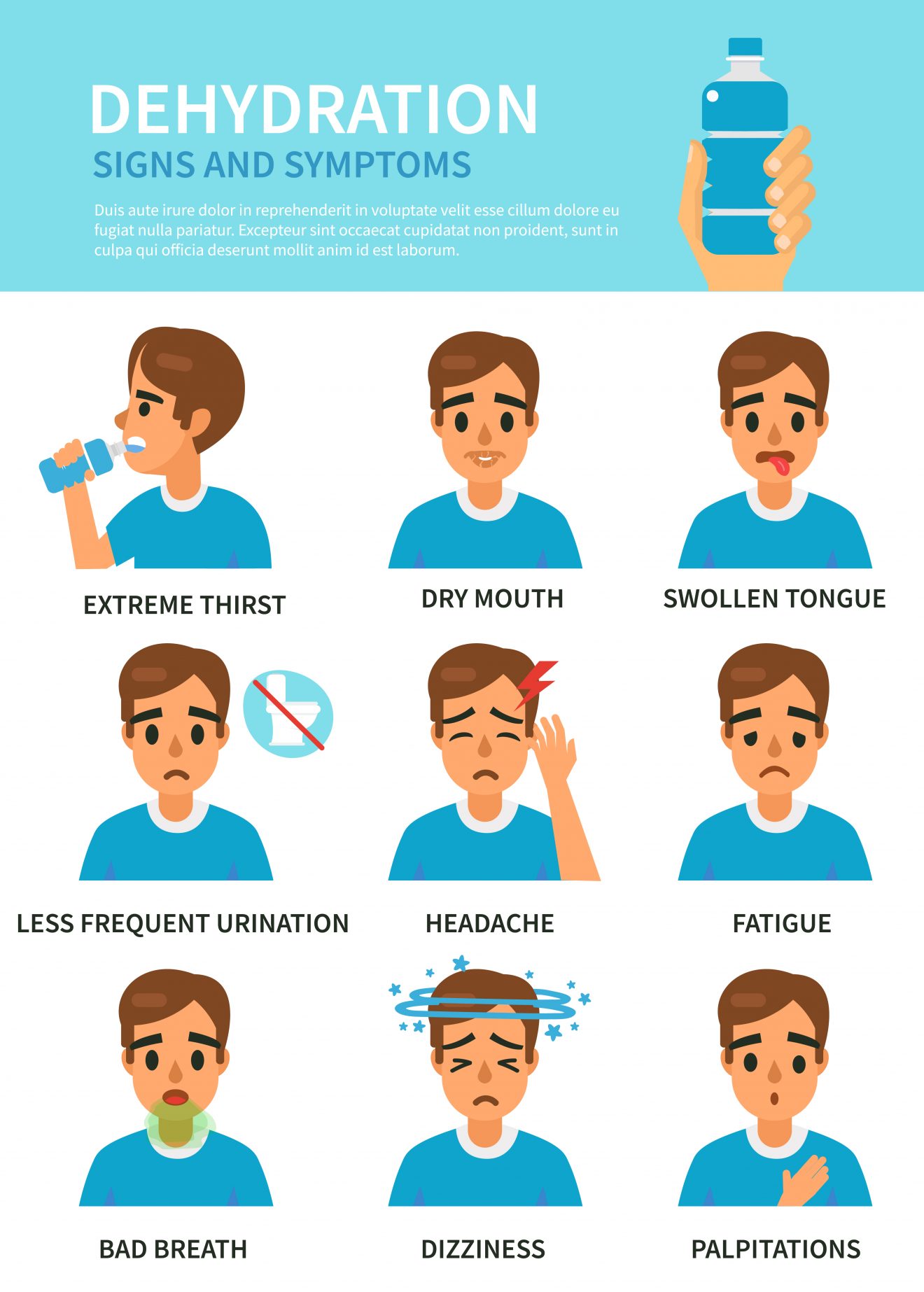Recognizing Early Dehydration Signs
Dehydration can manifest in various ways, and being aware of the early signs is crucial for maintaining optimal health. One of the most common indicators of initial dehydration is thirst. Thirst is your body’s way of signaling that it needs more fluids to function correctly. However, it is essential to note that thirst may not always be a reliable gauge, especially in older adults or individuals with certain medical conditions. Therefore, it is advisable to drink water regularly, even before feeling thirsty, to prevent dehydration.
Another early sign of dehydration is a dry mouth. Saliva helps keep your mouth moist, and its production decreases when your body is low on fluids. A dry mouth can lead to discomfort and difficulty swallowing, making it important to address this symptom promptly.
Additionally, monitoring the color of your urine can provide valuable insights into your hydration status. Dark-colored urine often indicates dehydration, while clear or light-yellow urine suggests adequate hydration. It is crucial to address these early symptoms promptly to prevent more severe dehydration, which can lead to complications such as heat injury, urinary tract infections, and kidney problems.
Identifying Advanced Dehydration Symptoms
As dehydration progresses, the body may exhibit more severe symptoms that require immediate medical attention. Dizziness is a common advanced symptom, which can lead to fainting or falls, especially in older adults. It is essential to address this symptom promptly to prevent potential injuries.
Fatigue is another advanced sign of dehydration. When the body is low on fluids, it may struggle to perform essential functions, leading to feelings of exhaustion and weakness. Prolonged dehydration can also impair cognitive function, making it difficult to concentrate or make decisions.
Rapid heartbeat or elevated pulse rate is a concerning symptom of dehydration, particularly in severe cases. This occurs when the heart works harder to compensate for the reduced blood volume caused by fluid loss. If left untreated, this can lead to serious complications such as heart failure or shock.
Other advanced dehydration symptoms include confusion, sluggishness, and in extreme cases, loss of consciousness. It is crucial to seek medical attention immediately if experiencing any of these symptoms, as they can indicate a life-threatening condition. Prompt treatment can help prevent further complications and ensure a swift recovery.
Dehydration in Special Populations
Certain groups are more susceptible to dehydration and may experience unique symptoms or require specific rehydration approaches. Understanding these differences can help ensure proper hydration and prevent complications.
Athletes, for example, lose fluids through sweat during intense physical activity, making them particularly prone to dehydration. In addition to the general symptoms, athletes may also experience muscle cramps, decreased performance, and reduced coordination. To address this, athletes should consume water or sports drinks before, during, and after exercise, and monitor their weight to ensure proper fluid balance.
Elderly individuals are another group at risk for dehydration due to factors such as decreased thirst sensation, chronic illness, and medication use. Dehydration in older adults can lead to severe consequences, including urinary tract infections, falls, and cognitive decline. Encouraging regular fluid intake, monitoring urine output, and addressing underlying medical conditions can help prevent dehydration in this population.
Children, too, are susceptible to dehydration due to their higher surface-area-to-mass ratio and increased fluid losses during play. Young children may not recognize or communicate their thirst effectively, making it essential for caregivers to encourage regular fluid intake. Signs of dehydration in children include fewer wet diapers, sunken eyes, and irritability.
Individuals with certain medical conditions, such as diabetes and kidney disease, may also experience unique dehydration symptoms and require specialized rehydration strategies. Consulting a healthcare professional is crucial for addressing dehydration in these populations.
Using Technology to Assess Hydration Levels
Advancements in technology have made it easier than ever to monitor and maintain proper hydration levels. Various devices and tools can help determine if you are dehydrated and provide insights into your hydration status.
Skin conductivity sensors, for example, measure the electrical conductivity of the skin to estimate hydration levels. These sensors can be found in smartwatches and fitness trackers, providing real-time feedback on your hydration status. However, it is essential to note that skin conductivity sensors may not be entirely accurate, as factors such as sweat rate and skin temperature can influence their readings.
Smart scales are another technological tool that can help monitor hydration levels. By measuring body weight and body fat percentage, these scales can provide insights into your overall health and hydration status. However, they may not be as accurate as other methods, such as blood tests, and should be used in conjunction with other hydration assessment tools.
Hydration monitoring apps can also help track fluid intake and provide reminders to drink water throughout the day. These apps can be particularly useful for individuals who struggle to maintain a consistent hydration routine or need help remembering to drink water regularly.
While technology can provide valuable insights into hydration status, it is essential to use these tools in conjunction with other methods, such as monitoring urine color and paying attention to early dehydration symptoms. It is also crucial to consult a healthcare professional if experiencing advanced dehydration symptoms or if concerned about hydration levels.
Home Tests to Determine Dehydration
In addition to technology, there are several simple home tests that can help determine if you are dehydrated. These tests can provide valuable insights into your hydration status and help you take appropriate action to address dehydration.
Skin Turgor Test
The skin turgor test involves pinching the skin on the back of your hand or the forehead and pulling it up gently. When you release the skin, it should snap back into place quickly. If the skin takes a while to return to its normal position, it may indicate dehydration. However, this test is not always accurate, especially in older adults or individuals with dry skin.
Tear Test
Another simple home test for dehydration is the tear test. When you blink, you should produce tears that moisten your eyes. If your eyes feel dry or if you have difficulty producing tears, it may indicate dehydration. However, this test is not always reliable, as factors such as allergies or eye drops can affect tear production.
Urine Color Test
Monitoring urine color is one of the most accurate ways to determine hydration status. Adequately hydrated individuals typically produce light-colored urine, while dark-colored urine may indicate dehydration. However, certain medications and supplements can affect urine color, so it is essential to consider other factors when interpreting these results.
While home tests can provide valuable insights into hydration status, it is essential to consult a healthcare professional if experiencing advanced dehydration symptoms or if concerned about hydration levels. Medical professionals can provide accurate assessments and appropriate treatment recommendations to address dehydration effectively.
Consulting a Healthcare Professional
If you suspect that you are experiencing dehydration or if you are unable to address dehydration through home remedies, it is essential to consult a healthcare professional. Medical professionals can provide accurate assessments and appropriate treatment recommendations to address dehydration effectively.
During a medical evaluation, healthcare professionals may use various tests and procedures to diagnose dehydration. These may include:
- Blood tests: Blood tests can provide insights into electrolyte levels, kidney function, and other indicators of dehydration.
- Urine tests: Urinalysis can help determine the concentration of your urine and provide insights into your hydration status.
- Physical examination: A healthcare professional may perform a physical examination to assess your overall health and check for signs of dehydration, such as dry skin, sunken eyes, or rapid heartbeat.
Based on the results of these assessments, medical professionals may recommend treatments such as intravenous (IV) fluids, oral rehydration solutions, or hospitalization in severe cases. It is essential to follow medical advice and seek prompt treatment if experiencing advanced dehydration symptoms.
To prevent dehydration, it is essential to maintain a consistent hydration routine, drink water regularly, and adjust fluid intake based on activity levels and environmental conditions. By being proactive in recognizing and addressing dehydration, individuals can promote overall health and well-being.
Preventing Dehydration: Best Practices
Preventing dehydration is essential for maintaining optimal health and well-being. By following best practices and maintaining a consistent hydration routine, individuals can avoid the negative consequences of dehydration and promote overall health.
Some strategies for preventing dehydration include:
- Drinking water regularly: Aim to drink at least eight glasses of water per day, and adjust your intake based on activity levels and environmental conditions. Consider using a hydration app or setting reminders to ensure you are drinking enough water throughout the day.
- Monitoring urine color: Check the color of your urine regularly to assess your hydration status. Adequately hydrated individuals typically produce light-colored urine, while dark-colored urine may indicate dehydration.
- Adjusting fluid intake based on activity levels: Increase your fluid intake before, during, and after exercise or other strenuous activities to compensate for fluid losses. Consider using sports drinks or other electrolyte-rich beverages to help replenish electrolytes and promote rehydration.
- Accounting for environmental conditions: In hot or humid weather, or at high altitudes, increase your fluid intake to account for increased fluid losses due to sweating or dry air.
- Incorporating hydrating foods into your diet: Foods with high water content, such as fruits and vegetables, can help contribute to your daily fluid intake and promote hydration.
By following these best practices and being proactive in recognizing and addressing dehydration, individuals can maintain optimal hydration levels and promote overall health and well-being.
Maintaining Optimal Hydration Levels
Maintaining optimal hydration levels is essential for overall health and well-being. By recognizing the signs of dehydration and taking proactive steps to address it, individuals can promote optimal hydration and prevent complications. Here are some recommendations for maintaining proper hydration levels:
- Drink water regularly: Aim to drink at least eight glasses of water per day, and adjust your intake based on activity levels and environmental conditions. Consider using a hydration app or setting reminders to ensure you are drinking enough water throughout the day.
- Monitor urine color: Check the color of your urine regularly to assess your hydration status. Adequately hydrated individuals typically produce light-colored urine, while dark-colored urine may indicate dehydration.
- Stay hydrated during exercise: Increase your fluid intake before, during, and after exercise or other strenuous activities to compensate for fluid losses. Consider using sports drinks or other electrolyte-rich beverages to help replenish electrolytes and promote rehydration.
- Account for environmental conditions: In hot or humid weather, or at high altitudes, increase your fluid intake to account for increased fluid losses due to sweating or dry air.
- Incorporate hydrating foods into your diet: Foods with high water content, such as fruits and vegetables, can help contribute to your daily fluid intake and promote hydration.
- Listen to your body: Pay attention to your body’s signals and respond promptly to early signs of dehydration, such as thirst and dry mouth.
By following these recommendations and maintaining a consistent hydration routine, individuals can promote optimal hydration levels and support overall health and well-being. Remember, staying hydrated is a crucial aspect of maintaining optimal health, so be proactive in recognizing and addressing dehydration.








